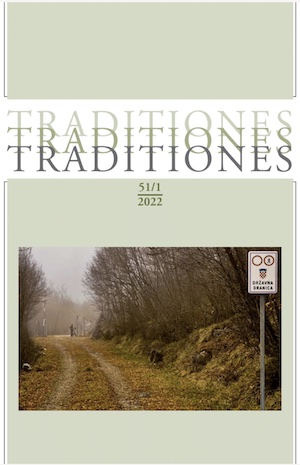Slovenska antropologija na pragu 21. stoletja: analiza tematskega polja skozi objave slovenskih antropologov
DOI:
https://doi.org/10.3986/Traditio2022510103Ključne besede:
slovenska antropologija, tematska analiza, 21. stoletje, analiza vsebinePovzetek
Izhajajoč iz temeljnega vprašanja, kaj je slovenska antropologija na pragu 21. stoletja, članek odkriva njene temeljne vsebinske značilnosti. Na podlagi analize vsebine 1162 znanstvenih člankov, poglavij, raziskovalnih poročil, poglavij v knjigah in knjig, objavljenih med letoma 2000 in 2021 in katerih avtorji so izbrani slovenski antropologi, članek detektira temeljne teme in tematske sklope ter na tej osnovi mapira vsebino, strukturo in povezanost polja slovenske antropologije. Rezultati kažejo, da: 1. je v slovenski antropologiji 25 tematskih sklopov, ki so po frekventnosti in kontinuiranosti razdeljeni v primarno, sekundarno in terciarno skupino; 2. da je polje slovenske antropologije sicer tematsko bogato in razgibano, vendar pa so teme razmeroma izolirane, ozko fokusirane in kažejo nizko stopnjo tematskega prepletanja; 3. da je polje močno feminizirano; 4. da ima nizko stopnjo mednarodnega dosega in pretežno osredinjeno na nacionalni kontekst ter 5. da ima tudi z vidika citiranosti razmeroma omejen znanstveni domet.
Prenosi
Literatura
Amit, Vered. 2006. Biographical Dictionary of Social and Cultural Anthropology. London, New York: Routledge.
Ballestero, Andrea. 2019. Anthropology of Water. Annual Review of Anthropology 48: 405–421. DOI: https://doi.org/10.1146/annurev-anthro-102218-011428.
Batchelder, Tim. 2005. An Anthropology of Air. The Townsend Letter Group. https://go.gale.com/ps/i.do?id=GALE%7CA138483355&sid=googleScholar&v=2.1&it=r&linkaccess=abs&issn=15254283&p=AONE&sw=w&userGroupName=anon%7Ea392718b (17. 3. 2022).
Bauer, Martin. 2000. Classical Content Analysis: A Review. V Qualitative Researching with Text, Image and Sound: A Handbook, ur. M. Bauer in G. Gaskell, 131–150. London: Sage.
Bell, Sandra, idr. 2008. What counts?: Volunteers and their Organisations in the Recording and Monitoring of Biodiversity. Biodiversity and Conservation 17 (14): 3443–3454.
Bernard, H. Russel 2006. Research Methods in Anthropology: Qualitative and Quantitative Approaches. New York: Altamira Press.
Borofsky, Robert. 2002. The Four Subfields: Anthropologists as Mythmakers. American Anthropologist 104 (2): 463–480. https://www.jstor.org/stable/683998.
Chelcea, Liviu in Ioana Iancu. 2015. An Anthropology of Parking: Infrastructures of Automobility, Work, and Circulation. Anthropology of Work Review 36 (2): 62–73. DOI: https://doi.org/10.1111/awr.12068.
Drisko, James W. in Tina Maschi 2016. Content Analysis. Oxford: Oxford University Press.
European Commission. 2012. Meta-Analysis of Gender and Science Research: Synthesis Report. Brussels: European Commission.
Eriksen, Thomas Hylland. 2004. What is Anthropology? London: Pluto Press.
Furrer, Oliver, Howard Thomas in Anna Goussevskaia. 2007. The Structure and Evolution of the Strategic Management Field: A Content Analysis of 26 Years of Strategic Management Research. International Journal of Management Reviews 10 (1): 1–23. DOI: https://doi.org/10.1111/j.1468-2370.2007.00217.x.
Hart, Keith. 2004. Notes Towards an Anthropology of the Internet. Horizontes Antropológicos 10 (21): 15–40. DOI: https://doi.org/10.1590/S0104-71832004000100002.
Hewes, Gordon W. 1957. The Anthropology of Posture. Scientific American 196 (2): 122–133.
Gravlee, Clarence C. in Elizabeth Sweet. 2008. Race, ethnicity, and racism in medical anthropology, 1977-2002. Medical Anthropology Quarterly 22 (1): 27–51. DOI: http://dx.doi.org/10.1111/j.1548-1387.2008.00002.x.
Korstanje, Maximiliano, E. 2015. The Anthropology of Airports, Criticism to Non Place Theory. Advances in Hospitality and Tourism Research 3 (1): 40–58. http://www.ahtrjournal.org/admin/dosyalar/9/3--essay-review.pdf.
Sangren, Steven. 2007. Anthropology of Anthropology?: Further Reflections on Reflexivity. Anthropology Today 23 (4): 13–16. DOI: https://doi.org/10.1111/j.1467-8322.2007.00523.x.
Stojanowski, Christopher M. in Jane E. Buikstra. 2005. Research Trends in Human Osteology: A Content Analysis of Papers Published in the American Journal of Physical Anthropology. American Journal of Physical Anthropology 128: 98–109. DOI: https://doi.org/10.1002/ajpa.20088.
Strauss, Sarah in Ben Orlove. 2003. Up in the Air: The Anthropology of Weather and Climate. London, New York: Routledge.
Wallerstein, Immanuel. 2003. Anthropology, Sociology, and Other Dubious Disciplines. Current Anthropology 44 (4): 453–465. DOI: https://doi.org/10.1086/375868.
Wood, Bernard. 2013. Four-Field Anthropology: A Perfect Union or a Failed State? Society 50: 152–155. DOI: http://dx.doi.org/10.1007/s12115-013-9633-5.
Prenosi
Objavljeno
Kako citirati
Številka
Rubrike
Licenca

To delo je licencirano pod Creative Commons Priznanje avtorstva-Nekomercialno-Brez predelav 4.0 mednarodno licenco.
Avtorji jamčijo, da je delo njihova avtorska stvaritev, da v njem niso kršene avtorske pravice tretjih oseb ali kake druge pravice. V primeru zahtevkov tretjih oseb se avtorji zavezujejo, da bodo varovali interese založnika ter da bodo povrnili morebitno škodo.
Podrobneje v rubriki: Prispevki






